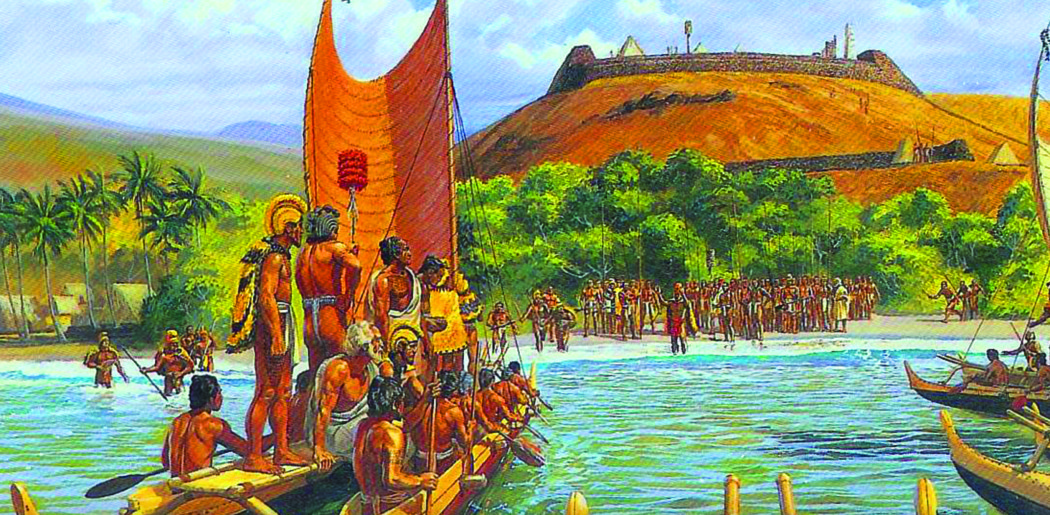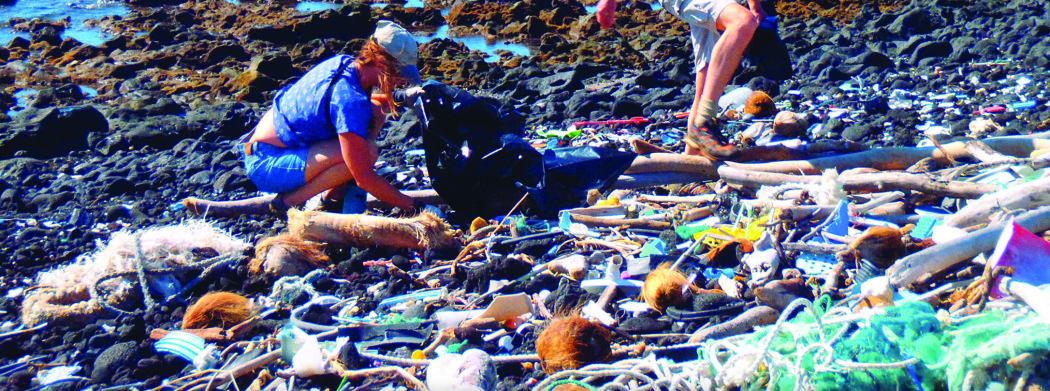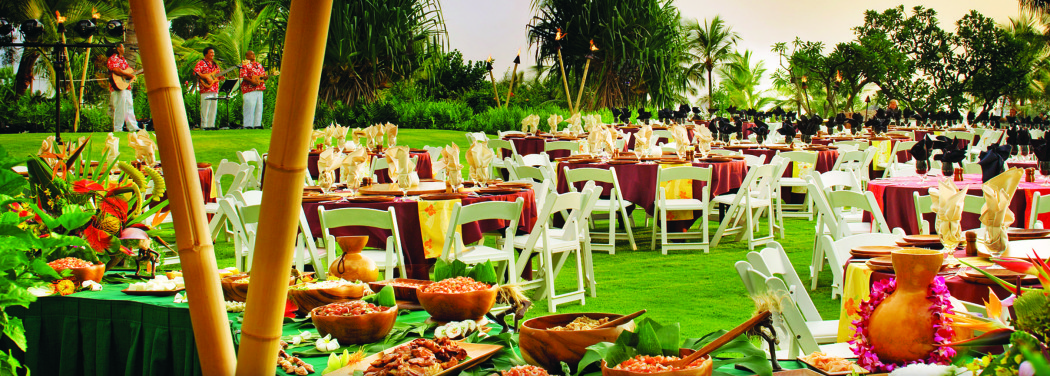
Then & Now: Pu‘ukohola
 By Robert Oaks
By Robert Oaks
Pu‘ukoholā Heiau, on the northwest coast of Hawai‘i Island, played a critical role in the unification of the island chain by King Kamehameha I in the late 18th and early 19th centuries. Indeed, of all the national parks on the island, this one is by far the most closely connected to Kamehameha himself. Dedicated to Kūkā‘ilimoku (Kū), the war god of Hawaiian kings, it was both one of the largest and one of the last great heiau built in the islands.
Kamehameha was probably born around 1758 in the Kohala district on the northern tip of the island, near the current village of Hawi. As nephew to Kalaniopu‘u, the ruler who had consolidated his authority over the entire island, the young boy was destined for greatness. Tall and powerful even as a child, Kamehameha reputedly lifted the two-and-one-half-ton Naha Stone when he was 14 years of age. According to tradition, whoever moved that stone (now resting in front of the Hilo Public Library) would conquer and unite the islands.
This was the first of several events predicting an auspicious future for the young man.
In the meantime, under his uncle’s tutelage, the young Kamehameha was trained in warfare and politics. He was present when the British explorer Captain James Cook landed at Kealakekua Bay (1778-1779). Cook’s lieutenant, James King, described Kamehameha as having “as savage a looking face as I ever saw.” Cook himself, of course, was slain at Kealakekua after an aborted attempt to kidnap Kalaniopu‘u in retaliation for the theft of a small boat by some local Hawaiians.
When the aged Kalaniopu‘u died a few years later in 1782, the unity of the island died with him. Kamehameha inherited some of Kalaniopu‘u’s authority, including responsibility for the war god Kū, but the rest went to others, and eventually the island was divided between Kamehameha and his cousin Keōua.
A stalemate ensued for several years, during which Kamehameha turned his attention to adding Maui to his domain. The power of the Naha Stone seemed to work. Invading in 1790, Kamehameha quickly conquered Maui, Lana‘i, and Moloka‘i, though he still controlled only half of his home island. From Moloka‘i, Kamehameha sent an envoy to a Kaua‘i soothsayer to discover what he needed to do to complete unification of all the islands. The soothsayer’s response: build a large heiau dedicated to the war god Kūkā‘ilimoku at Pu‘ukoholā (“Whale Hill”) on the Kohala coast near Kawaihae.
Before he could begin construction, however, Kamehameha had to hurry back from Maui to quash a rebellion by his cousin. After two bloody, but indecisive battles on the Hamakua coast, each retired to his own territory to prepare for the next round. Keōua led his forces, accompanied by many women and children, back to their home in Ka‘ū, passing Kīlauea Volcano on the way. It erupted for three days, ultimately killing more than 400 men, women, and children. Keōua himself was unhurt, but his morale was undoubtedly shaken by the display of disfavor from Pele, goddess of fire and volcanoes.
Meanwhile Kamehameha began building the heiau. The effort was as massive as the resulting structure. The stones, priests determined, should come from Pololū Valley, 20 miles away. Hundreds of Kamehameha’s followers came from all over his lands to pass many of the heiau’s heavy stones, one by one, by hand.
By the summer of 1791, the huge structure was nearing completion. Its dimensions were 224 by 100 feet, and it was surrounded by 20-foot high walls that were 20 feet thick at the base. But before it was finished, Kamehameha had to deal with another war, this time an invasion from the combined forces of O‘ahu, Moloka‘i, and Kaua‘i. Kamehameha suspended construction, marshaled his forces, and met the enemy in a bloody sea battle near the mouth of Waipi‘o Valley.
Kamehameha was aided in this battle by two Englishmen, Isaac Davis and John Young. They were captured in 1790 and handed over to Kamehameha. After an aborted escape attempt, Young decided to stay. It was through Young and Davis, that Kamehameha acquired European weapons and expertise, as well as a small American schooner, the Fair American.
The schooner had a single cannon, more than a match for the invaders’ canoes. Even so, this first naval battle in Hawai‘i was indecisive, and the invaders returned home, allowing Kamehameha to turn his attention once again to his heiau and to his cousin Keōua.
There remained only one task to complete the structure: a human sacrifice to the war god Kūkā‘ilimoku. Kamehameha sent messengers to his cousin, inviting him to Pu‘ukoholā, supposedly to discuss peace. Perhaps surprisingly, Keōua accepted the invitation, though he surely must have suspected Kamehameha’s motives.
Perhaps it was Pele’s warning at Kīlauea or maybe it was the display of superior weaponry in the recent sea battle off Waipi‘o Valley. Whatever his reason, Keōua, apparently resigned to his fate, headed north to Kohalā. According to some accounts, he cut off the tip of his penis so that he would be a less-than-perfect offering to the god.
Accompanied by 26 companions, Keōua approached Kawaihae Harbor in a double-hulled canoe. Kamehameha’s own war canoes were massed offshore; men armed with muskets and cannon lined the shore. The two cousins greeted each other, but as Keōua started to disembark, he was killed by a spear thrown by one of Kamehameha’s closest lieutenants. Most of Keōua’s companions were then killed before Kamehameha stepped in to stop the slaughter.
The bodies of Keōua and his companions were then sacrificed on the altar of Pu‘ukoholā (Keōua’s anatomical alteration notwithstanding), securing Kamehameha’s rule over the entire island of Hawai‘i. For several years, according to early western observers, the skulls of Keōua and his followers were displayed on a rail around the heieu as a warning sign to others who might wish to oppose Kamehameha.
It would still take nearly 20 more years to unite all the other islands, however. Most were eventually conquered by Kamehameha’s armies. Kaua‘i remained unconquered, but in the end was finally added to the kingdom through diplomacy in 1810, fulfilling the promise of the Naha Stone and the prophesy of the soothsayer from Kaua‘i.
Kamehameha died at Kailua-Kona in 1819. His son and heir Liholiho (Kamehameha II)—in order to escape the pollution of the death site—fled to the Pu‘ukoholā Heiau until after his father’s burial.
Upon his return, influenced by two of the old king’s powerful wives, Ka‘ahumanu and Keopuolani, Liholiho abolished the old religion, and the massive heiau was largely forgotten. More than a century later, in 1929, the Order of Kamehameha installed a plaque commemorating the site, but it did not become a national historic monument until 1966. Later, in 1972, Congress established the Pu‘ukoholā Heiau National Historic Site.
While the heiau is the most important monument in the park, it is by no means the only historical structure. Down the hill towards the sea are the ruins of the older and smaller Mailekini Heiau. This heiau predates the Pu‘ukoholā Heiau by several years, though the exact date is unclear. There had been apparently some consideration given to restoring and expanding Mailekini to fulfill the soothsayer’s prophesy, but a bigger and newer heiau was deemed more fortuitous. So Mailekina was abandoned as a religious site, though at some point Kamehameha had it converted into a fort, under the command of John Young, guarding the harbor with several ships’ guns obtained from traders.
The park also contains the site of John Young’s homestead. After the naval battle at Waipi‘o, Young married one of Kamehameha’s nieces, became a trusted political and military advisor, and eventually governor of Hawai‘i Island. His granddaughter was Queen Emma, wife of Kamehameha IV. The ruins of his European-style homestead are located near the northernmost point of the park. Isaac Davis, the other stranded Englishman, became governor of O‘ahu.
Each year, the park sponsors Ho‘oku‘ikahi Establishment Day (this year August 11-12, 2012) to celebrate the significance of the heiau with kahiko hula performances, mock battles, native craft making, and other cultural events. ❖
Contact writer Robert Oaks: boboaks@pacbell.net
For Further Reading:
- Cordy, Ross. Exalted Sits the Chief: The Ancient History of Hawai‘i Island. Honolulu: Mutual Publishing, 2000
- Greene, Linda Wedel. A Cultural History of Three Traditional Hawaiian Sites on the West Coast of Hawai’i Island. http://www.cr.nps.gov/history/online_books/kona/history.htm. National Park Service, 1993
- James, Van. Ancient Sites of Hawai‘i: Archaeological Places of Interest on the Big Island. Honolulu: Mutual Publishing, 1995
- Kirch, Patrick Vinton. Legacy of the Landscape: An Illustrated Guide to Hawaiian Archaeological Sites. Honolulu: University of Hawaii Press, 1996
- National Park Service, “Pu‘ukohola Heiau National Historic Site”, http://www.nps.gov/puhe/
- Oaks, Robert F. Hawai‘i, A History of the Big Island. Charleston, S.C.: Arcadia Publishing, 2003


